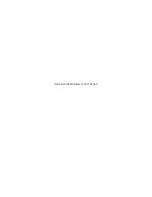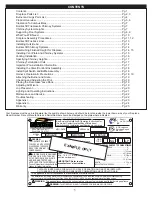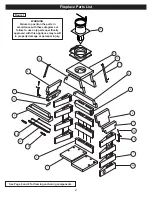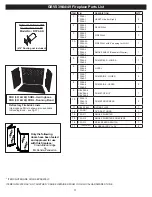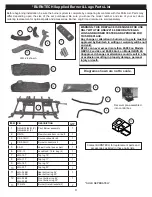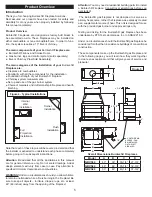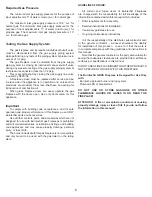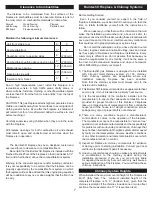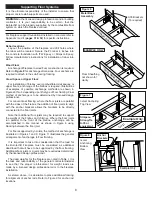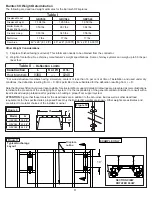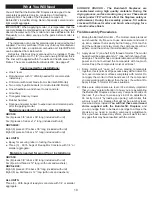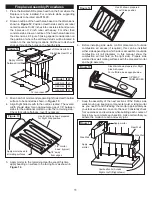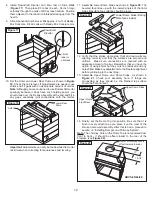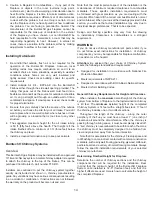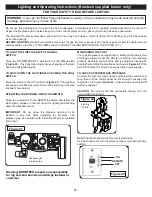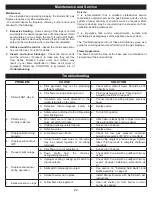
7
Clearance to Combustibles
The distance to be maintained from the surfaces of the
fireplace to combustibles must be observed. Below is a list of
the most common combustible materials to name a few:
Drywall
Wood flooring
Plywood
Sub-flooring
Wood Framing
Particle board
Mill board
Plywood paneling
Maintain the following minimum clearances:
Unit front, sides, rear
0”
0
Combustible floor
0”
0
Sheathing or trim to opening sides
8” (203 mm)
Combustible sheathing above opening top
8” (203 mm)
Mantel above opening
12” (305 mm)
Opening to side wall
20” (508 mm)
Insulation from firebox
0”
0
Due to high temperatures, never install this fireplace in a
recreational vehicle, in high traffic areas, drafty areas, or
where curtains, furniture, clothing, or other flammable objects
are less than 36” from the front or side and 42” from the top of
the fireplace.
CAUTION: This gas fireplace attains high temperatures. Keep
children and adults away from hot surfaces to avoid ignition of
clothing and/or burns. Even after the fireplace is shutdown it
will remain hot for a time afterward. Allow the surface to cool
before touching it.
Carefully supervise young children when they are in the room
with the fireplace.
All fireplace openings for both combustion air and exhaust
must remain open and unobstructed at all times when the
fireplace is in operation.
The Burntech® fireplace has been designed, tested and
approved for zero clearance to combustible floors.
Be certain that the Burntech® fireplace is installed with the
finished fire brick floor of the fireplace so that it is at least 4-1/2”
(four and a half inches) above the combustible floor system.
Warning to the structural engineer and/or building contractor:
It is your responsibility to be certain that the fireplace can be
properly supported by the combustible floor system on which
the fireplace will rest. Be advised that this engineering equation
will be in addition to any live or dead weights that the floor has
to carry.
Burntech® Fireplace & Chimney Systems
Before Getting Started…
Even if you consider yourself an expert in the field of
fireplace installation, we at
Burntech®
caution you to take the
time to totally familiarize yourself with the instructions to
follow.
We can assure you that there will be information that will
make the installation go smoother and, above all, safer, for
everyone concerned. At the least, reading these procedures will
save you time and, at the most, it will prevent any malfunction
that could result in property damage or serious injury.
Do not start the installation until you have checked out all
the local, regional, state and national rulings, laws and codes
as they apply to fireplaces and fireplace installations. Every
community is different so do not assume that because you
know the requirements for one locality, it will be the same in
the next. Avoid bureaucratic hassles and do your homework
WELL BEFORE you start your project!
The Burntech® gas fireplace is designed to be installed
with a B-vent metal chimney system, UL 103 chimney.
Such chimney systems are acceptable where any
traditional masonry fireplace has been specified.
Note that the chimney system must always vent to the
outside of the building.
This Burntech® fireplace is intended as a supplemental heat
source only. It is not intended as a primary heat source.
It is the responsibility of the contractor installer (not the
manufacturer) to ensure that adequate combustion air is
provided for proper function of this fireplace. Fireplaces
take up a large volume of replacement air from outside the
house and if the house is of airtight construction, smoke
spillage may occur if proper draft is not achieved.
There are many conditions beyond a manufacturer’s
control when it comes to the operation of the fireplace.
The manufacturer cannot be responsible for “smoke free”
operation, nor can the manufacturer take on the responsibility
for problems with surrounding construction; chimneys that
have not been built at the right heights; system drafts caused
by faulty mechanical systems; adverse weather conditions
or any other inclement environmental situations over which
the manufacturer has no control.
Inspect all fireplace & chimney components for evidence
of damage prior to starting installation. Consult your local
distributor for replacement parts if necessary.
Under no circumstances should you make any adjustments
or modifications to the chimney system during the
installation procedure. If you do, you are not only liable
for negating the warranty, but you could very well cause a
serious malfunction of the fireplace. You must follow these
chimney instructions.
Chimney System Heights
When installed, the maximum overall height of the Fireplace is
40’-0” (forty feet). The minimum installed height of the
completed fireplace is 14’ 0” (fourteen feet), given that the
chimney is straight. If the chimney includes one or more offset
sections, the measurement is 17’ 0” (seventeen feet).
1)
2)
3)
4)
5)
6)
Содержание GBVS 39
Страница 2: ...THIS PAGE INTENTIONALLY LEFT BLANK ...


